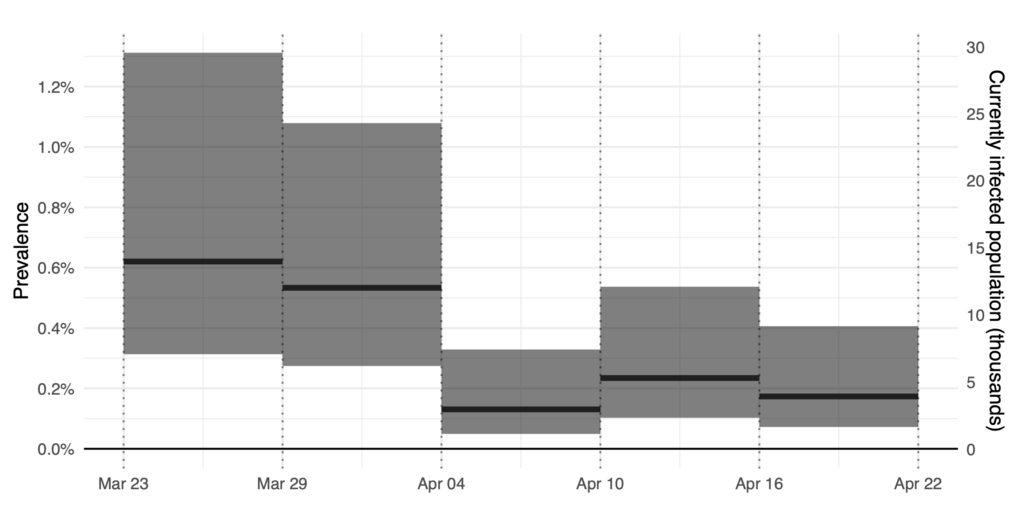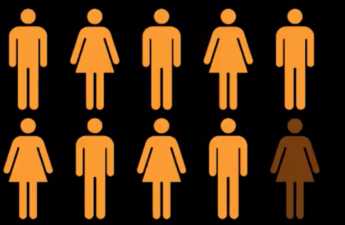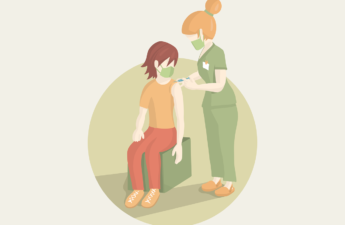James Apa Public Health – Seattle & King County

The number of COVID-19 infections in King County has been on the decline since the end of March, according to two recent reports.
One report is from the Bellevue-based Institute for Disease Modeling (IDM). The other is from Greater Seattle Coronavirus Assessment Network (SCAN), a disease surveillance initiative in partnership with Public Health – Seattle & King County.
The reports are consistent with Public Health’s COVID-19 surveillance data and together, provide complementary insights into the nature of COVID-19 transmission and prevalence across the county.
Latest findings from IDM’s transmission modeling
Working with Public Health – Seattle & King County and using updated data from the Washington Disease Reporting System (WDRS), the IDM model now shows the effective reproductive number – the number of new cases stemming from each COVID-19 infection – has consistently been below the critical threshold of 1 since March 29, with the estimate for April 15 between 0.28 and 1.0 and best estimate at 0.64.
This new estimate maps to the uncertainty range in their previous report but has increased precision supported by more information, including mortality data.
IDM estimates that since January 15, approximately 200 people per 10,000 in King County have been infected with COVID-19 (95% confidence interval between 68 and 480 in 10,000). This translates into approximately 46,000 people infected, which is about 10 times the number that had been reported at that time.
The report estimates the number of people with active COVID-19 infections was between 10 and 68 per 10,000 on April 20, with a best estimate of 29 per 10,000 (approximately 6600 people with active infection).
“We are grateful for the community’s response in the face of this pandemic,” said Dr. Mike Famulare, Principal Research Scientist at IDM. “The evidence is clear that our collective efforts have accomplished the goal of making our community substantially safer and healthier.
The next few months will be critical as we consider what activities may safely resume alongside increased containment measures.”
Two approaches, same epidemic – how transmission modeling and SCAN work together
Using WDRS data on all cases and deaths in the county, the IDM model simulates the hidden disease transmission process that results in those measurable outcomes. In contrast, SCAN surveys a cross section of people who wouldn’t otherwise be tested.
SCAN aims to identify that part of the epidemic iceberg that remains hidden, beneath the tip we can currently measure through case counts gathered from healthcare and other high-risk settings.
SCAN then uses the test results from a community sample and demographic data of survey participants, compares them to the demographics of King County as a whole, and then reweights the test results to provide an estimate of COVID-19 prevalence across the entire population.
As of Sunday, April 26, 2020, SCAN has tested 8,443 samples from volunteer respondents, adding data for 4,351 individuals since its previous report covering the period of March 23 to April 9.
Since community sampling began on March 23, SCAN has tested 5,194 samples from respondents with self-reported COVID-like illness (CLI) and 3,249 samples from respondents not reporting CLI symptoms.
Among individuals reporting CLI symptoms, 67 samples tested positive for COVID-19, while among those not reporting CLI symptoms, five samples tested positive. SCAN continues to enroll people who self-report CLI symptoms but have not sought medical care, helping to identify cases that might otherwise have gone undetected.
Combining data from SCAN participants with county census data for the period from April 16-21, 2020 statistical models estimate that community prevalence of COVID-19 was between 7 in 10,000 and 41 in 10,000.
This preliminary estimate is consistent with the latest findings on COVID-19 transmission in King County from the Institute for Disease Modeling (IDM), suggesting increased confidence that physical distancing measures are leading to a decline in active infections.
Together, both reports indicate that there were between 2,000 and 15,000 active infections on April 20th in the community across all parts of King County.
“Thanks to the more than 8,000 volunteers who’ve enrolled in SCAN to-date, we’re identifying cases that would not be captured through traditional testing methods,” said Jay Shendure, Scientific Director of the Brotman Baty Institute and SCAN’s lead partner. “It’s gratifying to see how our results are lining up with other sources of information— helping not only provide a more complete picture of this outbreak but also increasing our confidence in what we’re learning.”
SCAN is still seeking more participation from children and adolescents, as well as among key demographic groups (Black, Hispanic, or Latinx, and Native Hawaiian or Pacific Islander) to more accurately reflect the population of King County.
Data from the Washington State Disease Reporting System (WDRS) and Public Health – Seattle & King County indicates that these groups are disproportionately affected by the COVID-19 outbreak, and greater representation from these groups in the SCAN study is needed to direct public health resources where they are needed most.
We encourage individuals and parents of individuals who belong to these groups to enroll in the study at scanpublichealth.org.
SCAN’s enrollment website is now also available in Spanish, Vietnamese, and both Simplified and Traditional Chinese. Somali, Korean, and Russian versions of the site will launch on Monday, May 4, with additional languages to roll out the following week.
“These valuable studies are showing us that there is more COVID-19 in the community than meets the eye, reinforcing the importance of continuing our current distancing measures,” said Dr. Jeff Duchin, Health Officer for Public Health – Seattle & King County. “Although transmission has slowed, most people in our area remain vulnerable to infection and there are still too many cases reported each day. We need a better understanding of how people are being infected in order to further reduce the number of COVID-19 illnesses. At this time, staying home and way from others remains our best weapon against COVID-19.”
Report links:


